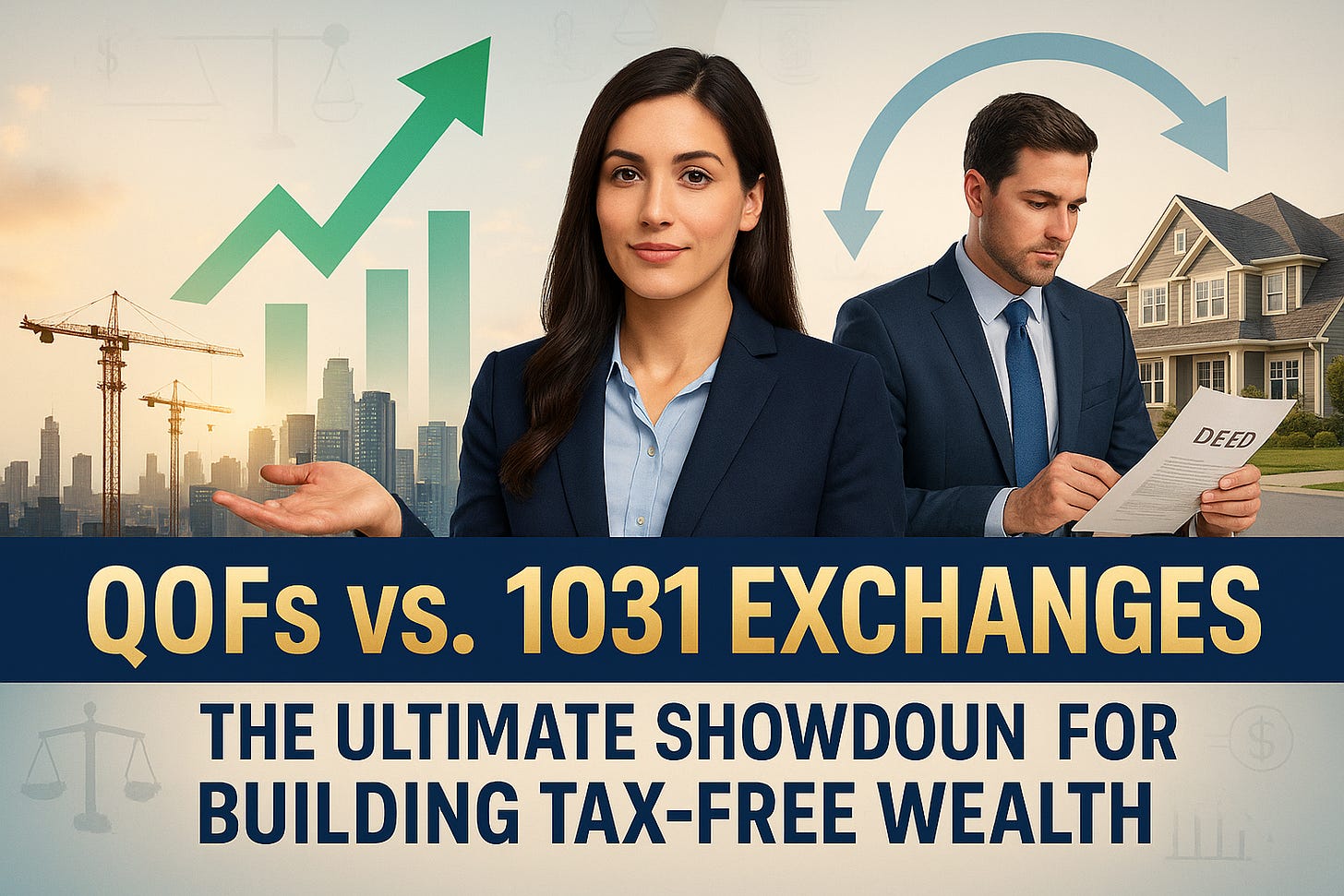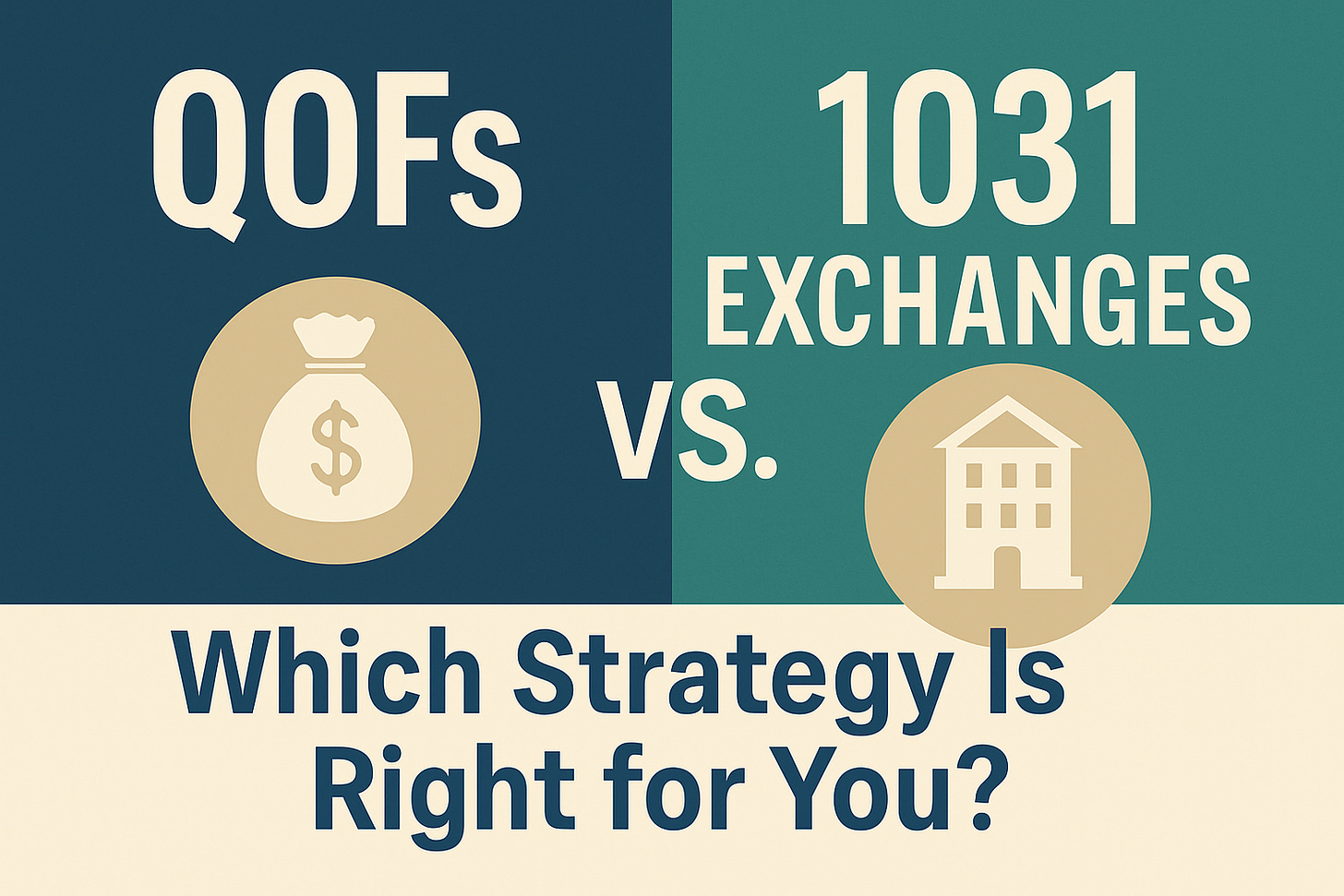QOFs vs. 1031 Exchanges: Which Strategy Is Right for You?
For decades, savvy investors have used the 1031 Exchange to defer capital gains on real estate. But since the Tax Cuts and Jobs Act of 2017, the Qualified Opportunity Fund (QOF) has emerged as a rival tool—offering not only tax deferral but also the potential for permanent tax-free growth.
So which strategy is right for you? Let’s break down how each works, their advantages, their pitfalls, and how advisors can guide clients in choosing the right fit.
What Is a 1031 Exchange?
A 1031 Exchange (named after IRS Code Section 1031) allows real estate investors to sell a property and reinvest the proceeds into a “like-kind” property without paying capital gains tax immediately.
Key benefit: Complete tax deferral as long as proceeds roll into another qualifying property.
Requirements:
Replacement property must be identified within 45 days of sale.
Transaction must close within 180 days.
Funds must be held by a Qualified Intermediary—investors cannot touch the money.
This is a tried-and-true method for real estate investors who want to upgrade properties or consolidate holdings without a tax hit.
What Is a Qualified Opportunity Fund (QOF)?
A QOF is an investment vehicle that channels capital into Qualified Opportunity Zones (QOZs)—designated economically distressed areas across the U.S.
Key benefit: Investors can defer capital gains from any source (not just real estate).
Requirements:
Gains must be invested in a QOF within 180 days of realization.
Funds must then be invested into qualifying projects (real estate or operating businesses) located in a QOZ.
Unlike 1031s, QOFs can accept gains from stock sales, business exits, or collectibles, opening the door for investors outside traditional real estate circles.
Tax Benefit Comparison
Feature 1031 Exchange Qualified Opportunity Fund Eligible gains Real estate only Any capital gain (real estate, stocks, business, etc.) Deferral period Indefinite (until property sold without exchange) Until Dec. 31, 2026 (when deferred gains are recognized) Step-up in basis Heirs may receive stepped-up basis at death No basis step-up, but tax benefits on QOF gains Tax-free growth No (deferred, not forgiven) Yes, after 10 years QOF growth is tax-free Liquidity flexibility Must roll proceeds into another property Can invest into funds covering real estate or businesses Complexity Requires strict timelines and “like-kind” rules Requires IRS compliance and fund structuring
When a 1031 Exchange Wins
For legacy property portfolios. Investors with large, low-basis properties who want to consolidate or diversify real estate without realizing taxable gains.
For estate planning. Since heirs may inherit property at a stepped-up basis, families can erase decades of gains tax-free.
For control-oriented investors. 1031s allow direct ownership of replacement property, rather than investing into a fund.
“A 1031 is like hitting the pause button on taxes while keeping control of your real estate empire,” notes one tax advisor.
When a QOF Wins
For non-real estate gains. Stock market investors, business sellers, or collectibles traders can all roll gains into QOFs.
For long-term growth. Gains held in a QOF for 10+ years are permanently tax-free, making it powerful for wealth accumulation.
For impact-minded investors. QOFs finance housing, infrastructure, and small businesses in underserved communities.
“QOFs democratize tax advantages beyond real estate, while channeling capital into communities that need it most,” says a fund manager.
Key Pitfalls and Risks
1031 Exchanges
The 45-day identification period is notoriously tight—bad deals get done just to meet deadlines.
Investors remain tied to real estate, which may not align with diversification goals.
QOFs
Sunset risk: Deferred taxes on original gains come due in 2026, regardless of fund performance.
Must vet fund managers carefully—poor compliance could blow the tax benefits.
QOFs are illiquid, with capital locked up for a decade to maximize benefits.
How Advisors Can Guide Clients
The choice between a 1031 Exchange and a QOF often comes down to:
Source of gains – If gains come from stocks, businesses, or collectibles, only QOFs apply.
Time horizon – If clients want indefinite tax deferral and estate planning benefits, 1031s shine. For 10+ year investors seeking tax-free growth, QOFs are compelling.
Client values – Some clients prioritize community impact; others just want maximum tax efficiency.
Advisors should also explore hybrid strategies. For example, an investor could complete a 1031 exchange into a property within a QOZ, and then later contribute that property into a QOF structure. Done right, this layers benefits.
Both 1031 Exchanges and Qualified Opportunity Funds offer powerful tax advantages, but they serve different investor profiles.
1031s are ideal for property owners wanting to keep rolling real estate gains indefinitely.
QOFs broaden the field, letting anyone with capital gains invest in distressed areas while potentially erasing new appreciation from taxation entirely.
In the end, the right choice depends on the investor’s goals, timeline, and appetite for impact investing. For advisors, mastering both strategies ensures they can tailor solutions to every client—from the lifelong landlord to the Silicon Valley founder with a tasty exit.


